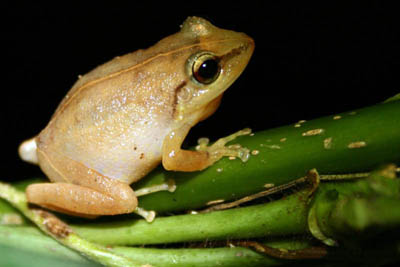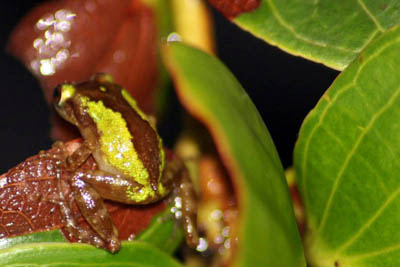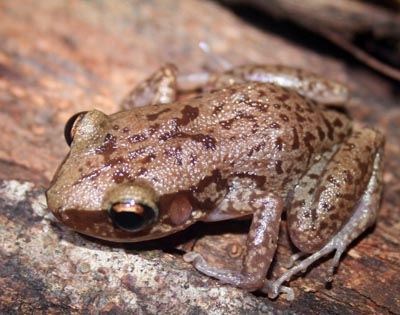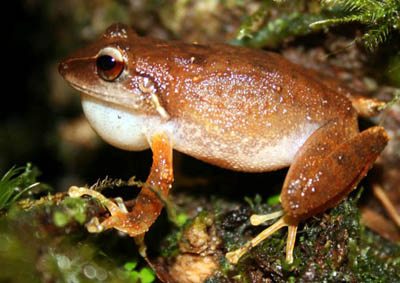
Coqui frogs part of Puerto Rican culture
SAN JUAN, P.R.— As Javier Soler sat on the plane heading home to San Juan, memories of his younger years in Puerto Rico filled his mind. He remembered learning about the Coquí frog in school and understanding its importance within his community.
He also remembered going away to college and being homesick for the song of the Coquís. His face lit up with joy as he reminisced and said, “I can’t wait to get home and eat dinner with my children and my wife on our terrace and listen to them sing. We really take it for granted sometimes.”
 |
This is a juvenile male of Eleuthero- dactylus coqui that was eating insects on the vines (Photo courtesy of Wilfredo Falcón Linero, University of Puerto Rico in Humacao). |
For Puerto Ricans, the Coquí frogs are not just a constant noise that is always in the background of their lives, creating a society without silence. Instead, they are a very special part of the culture and are highly revered in their native land of Puerto Rico.
An outsider would most likely find this continuous noise to be a raucous but to Puerto Ricans it’s a melodious tune that engulfs their days and nights. The affection that Puerto Ricans exude for this species is so profound that it is unlike any adoration that other countries feel toward their national symbol and island mascot.
“Had I not grown up here, it would have annoyed me,” said Soler. “But I really appreciate them and enjoy listening to them. They remind me of home.”
There are 17 different species of the Coquí frog found in Puerto Rico’s El Yunque National Forest. The entire Eleutherodactylus genus, the scientific name for the Coquí, is a type of frog that generally ranges from only three to four centimeters long.
They produce a two-tone sound that goes “KO-KEE,” hence the name. The two most common species found throughout the island are Eleutherodactylus portoricensis and Eleutherodactylus coquí.
Both male and female Coquís produce the sound. However, according to Victor Cuevas, an interpreter at El Yunque National Forest, the males make the biggest use of their vocal sounds.
“The males call to claim their territory, they call to bring females to their territory, and to warn of the presence of danger,” said Cuevas. “They’re basically saying this land is my land.”
These frogs are very persistent because they are constantly calling. Although, they are more active at night, their sounds can be heard anytime in almost any part of the country.
| Eleutherodactylus gryllus is found on the tree tops and fern tops in El Yunque National Forest (Photo courtesy of Wilfredo Falcón Linero, University of Puerto Rico in Humacao). |
 |
Although some species are endemic, meaning that they are native and stay confined to a particular place, some prefer high mountain areas, while others prefer low grassy areas. However, all of them favor warm humid climates, which is why Puerto Rico, and now other areas of the Caribbean and countries in South America are where they reside.
The Puerto Rican Coquí has also been transported to areas in the United States.
They were introduced into the Fairchild Tropical Gardens in Miami, but were reportedly eradicated in 1977 by rare freezing weather.
However, they can still be seen and heard on the islands of Hawaii. It is believed that a Coquí nest was transported from Puerto Rico to Hawaii in a plant and ever since, the inhabitants of Hawaii have been struggling to cope with them.
Hawaiians are annoyed with this frog because they are not used to the constant noise. The frog also does not have many natural predators in Hawaii and overproduction has become a major issue with the people of Hawaii.
Both the government and residents are killing the Coquís in ways that some Puerto Ricans find to be cruel. Hawaiians have resorted to burning the Coquís with acid or calcium hydroxide, which takes 45 minutes to kill the frogs and also kills off other natural plant and animal life. Some residents are also gathering them in large numbers and boiling them to their death.
| Eleutherodactylus monensis is an endemic species of Mona Island (west of Puerto Rico) (Photo courtesy of Wilfredo Falcón Linero, University of Puerto Rico in Humacao). |
 |
“I grew up with the Coquí so I’m used to their sound. It’s just a given that they will be there every night,” said Soler. “Hawaiians aren’t used to them and it makes me sad that they are killing them. Coquís are so friendly.”
In situations like this, there is an agreed upon official and more humane way to kill the frogs. In this manner, the Coquís are sprayed with a high concentration of caffeine, which is safer and more natural.
“Hawaiians are not using the official way to kill the Coquís because the government classified them as a pest,” said Cuevas. “In Hawaii, pests are not protected from cruelty.”
This has become a major issue because of the fact that many species have already become extinct and others are quickly becoming endangered. This is due to a fungus that grows in humid areas, which has been killing amphibians for years. It is impossible to destroy the fungus because it grows so rapidly and occurs all over the world. Puerto Ricans are worrying what will happen to their beloved frogs if the fungus continues killing populations on top of the killings by Hawaiians.
“It’s definitely a concern,” said Carlos Almodovar, an historian and San Juan National Historic Site park guide and interpreter. “We’re seeing and hearing them less and less especially as cities grow … and Hawaiian’s are just killing them off.”
It is clear that the Coquí has such an important role in the culture and history of Puerto Rico.
|
Eleutherodactylus portoricensis in El Yunque National Forest (Photo courtesy of Wilfredo Falcón Linero, University of Puerto Rico in Humacao). |
 |
“When I call my family in Puerto Rico, I can hear the Coquís in the background,” said Aimet Arill, who grew up in Puerto Rico, but currently lives in Miami Beach. “It makes me homesick because they are such a big part of the culture.”
The Coquís have a special place in the hearts of Puerto Ricans. They grew up listening to their song and living as one in a tropical paradise. The appreciation for this frog is lasting and reciprocal, as their blissful lullaby, clearly says, “co-qui,” which according to a legend, means, “I love you.”
If You Go
Visit El Yunque National Forest— From San Juan, Take the Airport Expressway, Highway 26, and follow the signs directing you east to Carolina. Once you are on the Expressway, follow it to the end (approximately 22.5 kilometers/14 miles). At the final exit (Carolina) stay in the left hand lane until you merge with PR Road 3. Continue on PR 3 for approximately 20.9 kilometers/13 miles until you see the signs for “Palmer-El Yunque.” Turn right at the traffic signal and follow the road through the village of Palmer until you see the sign for PR Road 191. Hint: there is a restaurant called “Noname”, painted a bright-turquoise on the corner!) Turn left on PR 191 and follow it for approximately 4 kilometers/2 miles until you see the El Yunque National Forest sign. The entrance to the El Portal Rain Forest Center is on your right-hand side just after you enter the forest. This will take about 45 minutes by car.
Hours: Daily from 7:30 a.m. to 6 p.m.
Activities— Hiking, bird-watching, picnicking, and enjoying waterfalls. There are limited facilities for handicapped. Wear comfortable clothing and safe shoes.
If you can’t make it to El Yunque and still want to hear the sound of the Coquí in Puerto Rico, go to a rural area, somewhere in the suburbs. The most guaranteed time to hear them is during the evening. If you can’t make it to Puerto Rico, but want to hear the Coquí, click on the two links below and imagine yourself in El Yunque absorbed in their song.
Single Coquí Singing— http://www.hear.org/alienspeciesinhawaii/species/frogs/1frog.wav.
Coquí Chorus:— http://www.hear.org/alienspeciesinhawaii/species/frogs/coqui_at_lava_tree_20001003_long.mpg.

Comments are Closed